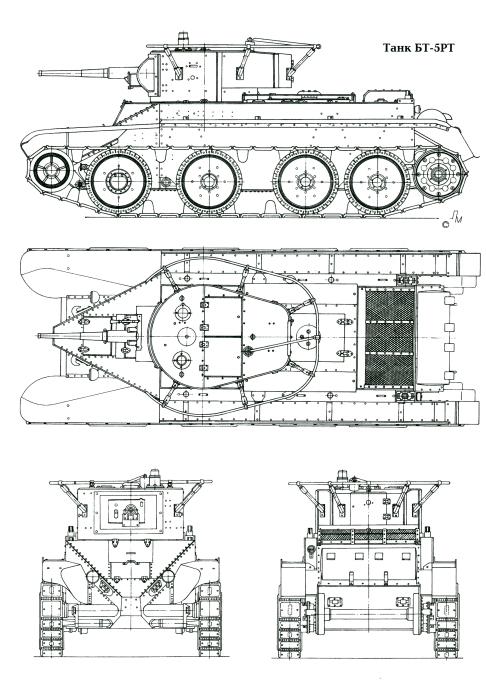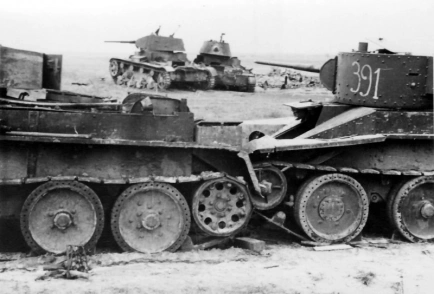[English version at the end]
MÁQUINAS DE BARBARROJA
¡Ya a la venta Barbarroja 03:00 hrs!
CARRO DE COMBATE LIGERO SOVIÉTICO BT-5

El BT-5 continúa la saga de la familia de carros ligeros iniciada con el BT-1 y 2. Comúnmente se les conoce como «Betka» o «Betushka» por su designación que obecede a las siglas BT de Bystrokhodnyj Tank (carro de combate veloz). Derivados del sistema estadounidense «Christie», son capaces de circular por carreteras sin cadenas sobre sus ruedas (el BT-5 desarrolla así 72 km/h.). Comienza su producción de serie en 1933 (continuará su construcción sólo hasta 1935) cuando se decide aumentar el poder de fuego con un cañón de 45 mm. M1932 20K, con 115 proyectiles, que necesita ser alojado en un torreta más espaciosa que la de su antecesor de serie, el BT-2. Solidaria con el cañón se le instala una ametralladora DT de 7,62 mm. con 2.709 cartuchos. Para la fecha la potencia de este cañón es equiparable o incluso superior a la de cualquier otro carro ligero e incluso medio del mundo.
Se le potencia con un motor de gasolina M-5 de 12 cilindros en V y 400 C.V., que es una versión mejorada del norteamericano «Liberty» (motor de aviación). La variante de carro de mando va equipada con radio y se designa como BT-5 RT (recordemos que en el inventario soviético las unidades de serie no montan radios). Es un vehículo rápido, ligero y maniobrable con un peso de 11,5 toneladas (13 mm. de máximo grosor de blindaje) y dotación de 3 hombres (jefe de carro/artillero, cargador/ametrallador y conductor). Existe una variante interesante denominada BT-5A, que monta una torreta diferente que aloja una pieza de artillería de 76,2 mm. También una se desarrolla una versión de carro lanzallamas. La planta de producción de Kharkov KhPZ (Kharkovskogo Parovozostroitelnogo Zavoda) será la cuna de todos ellos. La producción final totalizará las 1.884 unidades.

Los BT-5 experimentan su bautismo de fuego en la Guerra Civil Española como parte de la ayuda de Stalin en 1937 a la república española. Aquí es donde gozan de superioridad sobre las tanquetas italianas Ansaldo y los Panzerkampfwagen I de la Legión Cóndor. Interviene medio centenar de ellos, pero la mayor parte se perderán en los combates de las batallas de Teruel y Fuentes de Ebro (frente de Aragón). Otros serán capturados quedando integrados en el Ejército Español hasta los años 50. Volverán al campo de batalla en el coflicto de Khalkhin Gol en verano de 1939 contra las tropas niponas, integrados en dos brigadas ligeras de carros. Tras las experiencias de campo sufren modificaciones de estructura y motor. Tales mejoras darán como fruto un nuevo tipo, el BT-7. El 17 de septiembre de 1939 los BT-5 entrarán en el este de Polonia al ocupar la URSS esta zona en secreto acuerdo con el Tercer Reich. También participarán brigadas ligeras de BT-5 en la Guerra de Invierno contra Finlandia (1939-40).
En el momento de la Operación Barbarroja el 22 de junio de 1941, 1.672 carros de combate BT-5 constan como operativos en el inventario del RKKA (Ejército Rojo de Trabajadores y Campesinos). Están integrados en las siguientes unidades:
Distrito MIlitar Especial de Kiev
8º Cuerpo Mecanizado (Ryabyshev)
9º Cuerpo Mecanizado (Rokossovski)
22º Cuerpo Mecanizado (Kondrusev)
5º Cuerpo de Caballería (Kamkov)
Distrito MIlitar de Odessa
18º Cuerpo Mecanizado (Volokh)
2º Cuerpo Caballería (Belov)
Distrito Militar de Leningrado
1er Cuerpo Mecanizado (Romanienko)
Distrito Militar Occidental
6º Cuerpo Mecanizado (Khastkilevich)
11º Cuerpo Mecanizado (Mostovenko)
6º Cuerpo Caballería (Nikitin)

En 1941 ya es un vehículo obsoleto. No obstante en este periodo aún su mejor cualidad reside en el mencionado cañón de 45 mm. muy capaz contra los ligeros PzKpfw. I y II e incluso contra los PzKpfw. III. No obstante la mayor parte de ellos se perderá en el verano de 1941 frente a un enemigo con tácticas superiores y entrenamiento, la letal efectividad de la Luftwaffe que en el verano de 1941 goza de superioridad aérea en este vasto teatro de operaciones, la falta de repuestos y fallos mecánicos. De entre la descomunal cifra de 11.712 blindados perdidos por el RKKA desde el 22 de junio al 9 de julio de 1941, la tasa de atrición del BT-5 representa un 12%.
El 25 de junio de 1941, el general Rokossovski, en orden de marcha durante algunos días a través de Ucrania con su 9 Mekhanizirovannyj Korpus (9º Cuerpo Mecanizado) para hacer frente a la embestida del 1. Panzergruppe “Kleist”, sufre ataques aéreos y una constante merma en sus efectivos por averías en los vehículos. Así Rokossovski se ve obligado a hacer frente a dos divisiones Panzer, la 13ª (Rothkirch) y la 14ª (Kühn), las cuales se intentan hacer con el control de la carretera Lutsk-Rovno. Rokossovski, resignado, comenta sobre la realidad de su propio material: “La desgracia consistía en que el Cuerpo de Ejército de “mecanizado” sólo tenía el nombre. Miraba con amargura durante la marcha a nuestros viejos T-26, BT-5 y unos cuantos BT-7, comprendiendo que no aguantarían prolongados combates.”…

Los pocos BT-5 supervivientes del verano de 1941 proseguirán en servicio activo en todos los frentes hasta bien entrado 1943, incluso en los frentes de Leningrado y Carelia hasta 1944. Las unidades capturadas por la Wehrmacht recibirán la denominación Panzerkampfwagen BT 742(r). Casi todos quedarán destruidos durante la Operación Tifón (Batalla de Moscú) en diciembre de 1941.
¿Te ha resultado de interés este artículo? ¿Querrías conocer los detalles de esta y las demás operaciones?
¡Adquiere la obra cronológica Barbarroja 03:00h en edición de coleccionista!
Deja tu comentario abajo y sigue CONQUISTAR RUSIA punteando en la opción «SEGUIR / FOLLOW» a la izquierda de la página
[English version]
BARBAROSSA’S MACHINES
SOVIET LIGHT TANK BT-5

The BT-5 continues the family saga of the fast and maneuverable light tanks started with the BT-1 and 2. All of them are known as «Belka» or «Betushka» due to their BT official designation, this coming from Bystrokhodnyj Tank (fast tank). They are developed after the USA Christie concept, capable to travel at superior speeds on paved surfaces on their wheels without tracks (the BT-5 at 72 km/h.). Its series production starts in 1933 (only up to 1935) when its firepower is significantly augmented by replacing the former 37 mm. gun by a 45 mm. M1932 20K cannon. It will be lodged in a different and more roomy turret than the BT-2. It carries now 115 heavier projectiles and it is fitted with a coaxial 7.62 mm. DT machine gun (2,709 rounds). At the time this weapon’s firepower surpasses that of any other light or even medium tank in the world.
It is driven by a 12 cylinder 400 h.p. M-5 powerplant (an enhanced design of the US aviation-type «Liberty» engine). The command version is fitted with a radio set and it is known as BT-5 RT (in the Soviet inventory series tanks are still not carrying radio sets). It is a fast, light and agile armoured vehicle weighing 11.5 tonnes (maximum armour 13 mm.) and it is crewed by three men (commander/gunner, loader/machine gunner and driver). There is an interesting version, the BT-5A, with a larger turret that lodges a 76.2 mm. howitzer. A flamethrower sub-variant based on the BT-5 is also produced in limited quantities. The Kharkov KhPZ (Kharkovskogo Parovozostroitelnogo Zavoda) production centre will be the cradle of all of them. 1,884 units will be rolled out.

The BT-5 experiences its baptism of fire during he Spanish Civil War in 1937 as part of Stalin’s aide to the Spanish Second Republic. In Spain they will enjoy a clear superiority over their counterparts, the Italian Ansaldo tanquettes and the German Legion Condor Panzerkampfwagen I‘s. 50 units intervene in the conflict but most of the BT-5‘s are lost during the Battle for Teruel and Fuentes de Ebro (Aragon Front). Some will be captured by the Nationalist Army and operationally used until the 50’s in the new Spanish Army. They will participate as well in 1939 in the Khalkhin Gol conflict against the Japanese fielded in two tank brigades. After these field lessons they will be modified (engine and structure). The result of all this will be a new type of vehicle, the BT-7. On the 17th of September, 1939, BT-5‘s will take part in the RKKA (Red Army) occupation of Eastern Poland arranged by virtue of secret agreement between Hitler and Stalin. Shortly thereafter they are to see action again during the Winter War (1939-40) against Finland as part of several light tank brigades.
At Operation Barbarossa start on the 22nd of June, 1941, 1,672 units are listed as operational in the RKKA ranks. The order of Battle is as follows:
Kiev Special Military District
8th Mechanized Corps (Ryabyshev)
9th Mechanized Corps (Rokossovski)
22nd Mechanized Corps (Kondrusev)
5th Cavalry Corps (Kamkov)
Odessa Military District
18th Mechanized Corps (Volokh)
2nd Cavalry Corps (Belov)
Leningrad Military District
1st Mechanized Corps (Romanienko)
Western Military District
6th Military Corps (Khastkilevich)
11th Mechanized Corps (Mostovenko)
6th Cavalry Corps (Nikitin)

In 1941 is already an obsolete tank. Nevertheless at this time its best quality still lays in its 45 mm. cannon, capable to engage the light PzKpfw I’s and II’s and even the medium PzKpfw III’s. However most of them will be lost during the summer, 1941 against an enemy with superior tactics and training, the lethal Luftwaffe which masters the skies, lack of spare parts and mechanical breakdowns. Out of the breathtaking figure of 11.712 tanks lost by the RKKA from the 22nd of June, 1941 until the 9th of July, 1941, the attrition rate of the BT-5 reaches the 12%.
On the 25th of June, 1941, General Rokossovski is on his way west with his 9 Mekhanizirovannyj Korpus (9th Mechanized Corps) to engage 1. Panzergruppe “Kleist” (Ukraine), enduring air strikes and suffering attrition due to mechanical breakdowns. This way Rokossovski engages two Panzer divisions, the 13th (Rothkirch) and the 14th (Kühn), which are struggling to take control of the road Lutsk-Rovno. Bitterly the Soviet General highlights the shortcomings of its own materiel: “To our disgrace our Army Corps was only “mechanized” in its designation. During the route I looked in despair at our old T-26’s, BT-5’s and a few BT-7’s understanding that they would not withstand long combat…”

The few surviving BT-5‘s from the summer of 1941 will still be employed in all fronts until 1943, even in the Leningrad and Carelian fronts until 1944. The captured units will be used in the Wehrmacht inventory with the designation Panzerkampfwagen BT 742(r). Almost all of these «germanized» tanks will be destroyed during Operation Typhoon (the Battle for Moscow) in December, 1941.
Did you find this article interesting? Leave your comments below and follow us clicking on «SEGUIR / FOLLOW» at the left of the page



Una respuesta a “BT-5”